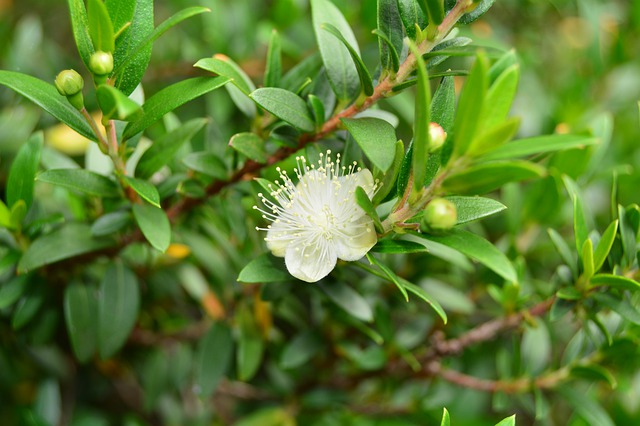 Myrtle (Myrtus communis) is an evergreen perennial shrub belonging to the Myrtaceae family of plants. The plant possesses multiple stems and produces a white flower, being found growing in humid regions of Southern Europe, North Africa, Western Asia and India. Myrtle has been used in traditional medicine for its healing properties including as a digestive and respiratory aid. These healing properties may originate from its high content of antioxidants, and its anti-inflammatory, antibacterial and antihyperglycaemic effects. Myrtle also possesses sedative, hypnotic and mood elevating properties. For example, in one study researchers administered myrtle leaf extracts to mice and rats. The animals treated with myrtle obtained significantly more sleep compared to control animals, although this was accompanied by a decrease in REM sleep (dream sleep). There was also a significant reduction in muscle tone and increase in exploratory behaviour in the animals, suggesting a significant hypnotic and anxiolytic effect.
Myrtle (Myrtus communis) is an evergreen perennial shrub belonging to the Myrtaceae family of plants. The plant possesses multiple stems and produces a white flower, being found growing in humid regions of Southern Europe, North Africa, Western Asia and India. Myrtle has been used in traditional medicine for its healing properties including as a digestive and respiratory aid. These healing properties may originate from its high content of antioxidants, and its anti-inflammatory, antibacterial and antihyperglycaemic effects. Myrtle also possesses sedative, hypnotic and mood elevating properties. For example, in one study researchers administered myrtle leaf extracts to mice and rats. The animals treated with myrtle obtained significantly more sleep compared to control animals, although this was accompanied by a decrease in REM sleep (dream sleep). There was also a significant reduction in muscle tone and increase in exploratory behaviour in the animals, suggesting a significant hypnotic and anxiolytic effect.

A number of phytochemicals have been identified within myrtle that may explain the hypnotic effects of myrtle. These include a range of monoterpenes, including 1,8-cineole, limonene, linalool and α-terpineol. Studies linalool, 1,8-cineole and α-terpineol possess sedative properties. Myrtle may therefore be a useful treatment for insomnia and sleep disorders, particularly if this originates from stress related anxiety or depression.
Eat Well, Stay Healthy, Protect Yourself
RdB
